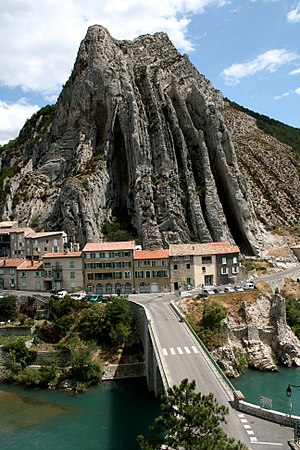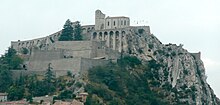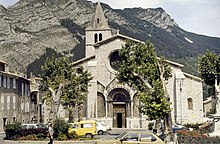Sisteron
| Sisteron | ||
|---|---|---|

|
|
|
| region | Provence-Alpes-Cote d'Azur | |
| Department | Alpes-de-Haute-Provence | |
| Arrondissement | Forcalquier | |
| Canton | Sisteron | |
| Community association | Sisteronais-Buëch | |
| Coordinates | 44 ° 11 ' N , 5 ° 57' E | |
| height | 448-1,145 m | |
| surface | 50.25 km 2 | |
| Residents | 7,460 (January 1, 2017) | |
| Population density | 148 inhabitants / km 2 | |
| Post Code | 04200 | |
| INSEE code | 04209 | |
| Website | www.sisteron.com | |
 Sisteron's landmark: ribs made of hard limestone |
||
Sisteron is a French municipality with 7460 inhabitants (at January 1, 2017) in the department of Alpes-de-Haute-Provence and the region Provence-Alpes-Cote d'Azur . It belongs to the Arrondissement Forcalquier .
The name of the place is pronounced with an unstressed "e", [sistəʀɔ̃]. In Provençal they say Sisteroun .
geography
Sisteron is located on the banks of the Durance just behind the tributaries of the Buëch and the Sasse , 135 kilometers from Marseille and Grenoble and 180 kilometers from Nice . The place with the nickname "Porte de la Provence" ('Gate to Provence') is located on the border of the Dauphiné between two mountain ranges, Baume / Gache and the Montagnes de Lure / Moulard. Sisteron attracts numerous tourists due to its climate (300 days of sunshine a year), its diverse landscape, its waters and its airport.
history
The area has been inhabited for around 4000 years. Sisteron itself was under the name Segustero in Roman times a station on the Via Domitia , which connected Italy with the Rhone Delta . On the road to Authon there are still inscriptions that were carved into the rock at that time. Sisteron was spared from the Great Migration, but later plundered by the Saracens .
In the 6th century Sisteron became the seat of a diocese that existed until 1790. In the 11th century, the Counts of Forcalquier built a fortress near the city on the border with the county of Provence . In 1193, Count Alfonso II of Provence married the heir to the Count of Forcalquier Garsende de Sabran , reuniting the two areas.
The city of Sisteron came to France in 1483, when Provence was inherited by King Louis XI. fell. During this time, the place was affected six times by epidemics, which killed two thirds of the population. From 1562 to 1594, during the Huguenot Wars , Sisteron was fought over and besieged twice. The current city walls and today's citadel of Sisteron , which were built by Jean Errard from Bar-le-Duc , date from this period . On the orders of Richelieu , Prince John Casimir of Poland was imprisoned here from February 13 to August 16, 1639 , after he was arrested on a trip to Spain in Marseille and initially held for several months in the archbishop's palace in Salon-de-Provence .
During the French Revolution , Sisteron remained royalist. When Napoléon Bonaparte fled his exile on Elba in 1815 and landed with a small group of followers in Golfe-Juan to move to Paris, the crossing over the Durance at Sisteron was one of the critical points on his route where military resistance rose and his march to Paris would have been ended relatively easily by troops loyal to the king. However, the governor of the province, Marshal André Masséna , had given the precautionary order to withdraw all troops and supplies from Sisteron. The bridge at Sisteron, abandoned by their guards, was therefore occupied without a fight by an advance guard of forty men under the command of Pierre Cambronne in the morning hours of March 4th , and Napoleon, who had only one infantryman and a gendarme left for personal guarding, pulled welcomed by the mayor and the sub-prefect unmolested in Sisteron. After recruiting five more people in Sisteron and changing his exhausted horse, he set out with a vanguard that same day for Gap , where he arrived in the evening hours.
On August 15, 1944, Sisteron was bombed by English and American planes, killing around a hundred of the city's residents.
Population development
| year | 1962 | 1968 | 1975 | 1982 | 1990 | 1999 | 2008 | 2017 |
| Residents | 5325 | 6289 | 7243 | 6470 | 6594 | 6964 | 7251 | 7460 |
| Sources: Cassini and INSEE | ||||||||
Attractions
See also: List of Monuments historiques in Sisteron
- Citadel of Sisteron
- Notre-Dame des Pommiers Cathedral , an outstanding example of Lombard- Provençal architecture from the 12th century
- Bridge over the Durance
- Towers of the city fortifications
- Old town
- Bridges over the Buëch
- Dominican monastery
Personalities
- Jacques Gaffarel (* 1601 in Mane near Forcalquier , † 1681 in Sisteron), orientalist and occultist, confidante of Richelieu
- Jean-Baptiste Gastaldi (* 1674 in Sisteron, † 1747 in Avignon ), medic
- Joseph Philippe François Deleuze (* 1753 in Sisteron, † 1835 in Paris ), naturalist
- Paul Arène (* 1843 in Sisteron, † 1896 in Antibes ), storyteller and playwright
Twin cities
- Herbolzheim in Baden-Württemberg, since 1975
- Fidenza in Italy, since 1989
- Oliva in Spain
See also
literature
- Édouard de Laplane: Histoire de Sisteron, tirée de ses archives. Reprint of the 1843 edition, Laffette, Marseille 1974, 2 volumes.
- Pierre de Gombert: Napoléon de l'île d'Elbe à la citadelle de Sisteron. Éditions du Socle, Aix-en-Provence 1968.


